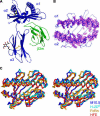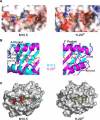Structure of a pheromone receptor-associated MHC molecule with an open and empty groove
- PMID: 16089503
- PMCID: PMC1174912
- DOI: 10.1371/journal.pbio.0030257
Structure of a pheromone receptor-associated MHC molecule with an open and empty groove
Abstract
Neurons in the murine vomeronasal organ (VNO) express a family of class Ib major histocompatibility complex (MHC) proteins (M10s) that interact with the V2R class of VNO receptors. This interaction may play a direct role in the detection of pheromonal cues that initiate reproductive and territorial behaviors. The crystal structure of M10.5, an M10 family member, is similar to that of classical MHC molecules. However, the M10.5 counterpart of the MHC peptide-binding groove is open and unoccupied, revealing the first structure of an empty class I MHC molecule. Similar to empty MHC molecules, but unlike peptide-filled MHC proteins and non-peptide-binding MHC homologs, M10.5 is thermally unstable, suggesting that its groove is normally occupied. However, M10.5 does not bind endogenous peptides when expressed in mammalian cells or when offered a mixture of class I-binding peptides. The F pocket side of the M10.5 groove is open, suggesting that ligands larger than 8-10-mer class I-binding peptides could fit by extending out of the groove. Moreover, variable residues point up from the groove helices, rather than toward the groove as in classical MHC structures. These data suggest that M10s are unlikely to provide specific recognition of class I MHC-binding peptides, but are consistent with binding to other ligands, including proteins such as the V2Rs.
Figures





Similar articles
-
MHC homologs in the nervous system--they haven't lost their groove.Curr Opin Neurobiol. 2006 Jun;16(3):351-7. doi: 10.1016/j.conb.2006.05.007. Epub 2006 May 15. Curr Opin Neurobiol. 2006. PMID: 16698261 Review.
-
Functional expression of murine V2R pheromone receptors involves selective association with the M10 and M1 families of MHC class Ib molecules.Cell. 2003 Mar 7;112(5):607-18. doi: 10.1016/s0092-8674(03)00153-3. Cell. 2003. PMID: 12628182
-
Direct peptide-regulatable interactions between MHC class I molecules and tapasin.Proc Natl Acad Sci U S A. 2006 Nov 28;103(48):18220-5. doi: 10.1073/pnas.0605131103. Epub 2006 Nov 20. Proc Natl Acad Sci U S A. 2006. PMID: 17116884 Free PMC article.
-
Structural Definition of Duck Major Histocompatibility Complex Class I Molecules That Might Explain Efficient Cytotoxic T Lymphocyte Immunity to Influenza A Virus.J Virol. 2017 Jun 26;91(14):e02511-16. doi: 10.1128/JVI.02511-16. Print 2017 Jul 15. J Virol. 2017. PMID: 28490583 Free PMC article.
-
Three-dimensional structures of MHC class I-peptide complexes: implications for peptide recognition.Arch Immunol Ther Exp (Warsz). 2000;48(3):135-42. Arch Immunol Ther Exp (Warsz). 2000. PMID: 10912617 Review.
Cited by
-
The quest for better understanding of HLA-disease association: scenes from a road less travelled by.Discov Med. 2013 Sep;16(87):93-101. Discov Med. 2013. PMID: 23998445 Free PMC article. Review.
-
Expression of nonclassical class I major histocompatibility genes defines a tripartite organization of the mouse vomeronasal system.J Neurosci. 2008 Mar 5;28(10):2332-41. doi: 10.1523/JNEUROSCI.4807-07.2008. J Neurosci. 2008. PMID: 18322080 Free PMC article.
-
MHC molecules in health and disease: At the cusp of a paradigm shift.Self Nonself. 2011 Jan;2(1):43-48. doi: 10.4161/self.2.1.15757. Epub 2011 Jan 1. Self Nonself. 2011. PMID: 21776334 Free PMC article.
-
Proofreading of Peptide-MHC Complexes through Dynamic Multivalent Interactions.Front Immunol. 2017 Feb 8;8:65. doi: 10.3389/fimmu.2017.00065. eCollection 2017. Front Immunol. 2017. PMID: 28228754 Free PMC article. Review.
-
Risk for intentional violent death associated with HLA genotypes: a preliminary survey of deceased American organ donors.Genetica. 2009 Dec;137(3):253-64. doi: 10.1007/s10709-009-9369-8. Epub 2009 Jun 3. Genetica. 2009. PMID: 19495996
References
-
- Dulac C, Torello AT. Molecular detection of pheromone signals in mammals: from genes to behaviour. Nat Rev Neurosci. 2003;4:551–562. - PubMed
-
- Stowers L, Holy TE, Meister M, Dulac C, Koentges G. Loss of sex discrimination and male–male aggression in mice deficient for TRP2. Science. 2002;295:1493–1500. - PubMed
-
- Dulac C, Axel R. A novel family of genes encoding putative pheromone receptors in mammals. Cell. 1995;83:195–206. - PubMed
-
- Matsunami H, Buck LB. A multigene family encoding a diverse array of putative pheromone receptors in mammals. Cell. 1997;90:775–784. - PubMed
Publication types
MeSH terms
Substances
Grants and funding
LinkOut - more resources
Full Text Sources
Other Literature Sources
Research Materials
Miscellaneous

